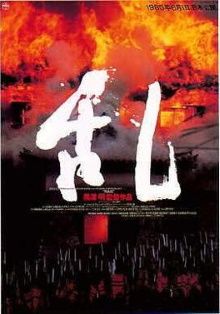Ran was Akira Kurosawa’s last epic and is one of his most famous films despite it being made so late in his career. It’s considered an adaptation of Shakespeare’s King Lear though it seems that the director was originally inspired by a real figure from Japanese history Mōri Motonari. While Kurosawa was never a very subtle director, I found this to be much too heavy-handed and obvious for my tastes, like a lavish, exaggerated stage play. It does look incredibly beautiful and being the most expensive Japanese film ever made at the time, features some of the most impressive large-scale period battles put on film. It even manages to convey the effective use of tactics to win battles!
The warlord Hidetora Ichimonji has won countless battles and gained control over the entire region. Now elderly, he decides to give each of his three castles to his three sons and designates the eldest son Taro as the head of the house. The youngest son Saburo objects, saying that they live in an era of war where personal strength matters most of all and this would be showing weakness. In response Hidetora banishes both Saburo and the adviser Tango who supports him. However when Hidetora goes to stay at the First Castle now under the control of Taro, Taro’s wife the Lady Kaede urges her husband to assert his authority over his father and deny hospitality to his retinue. Angered, Hidetora goes to the castle of his second son Jiro and is treated no better as Jiro’s vassals urge him to seize power from his elder brother. When he goes to the Third Castle abandoned by the soldiers still loyal to Saburo, he is besieged and defeated by the forces of his two elder sons and is finally driven mad.
If you know the story of King Lear then you already know how the plot here will play out. Even if you don’t, everything is telegraphed and signposted so obviously that things can only ever go one way. While I don’t expect twists in every film, it gets a little tiresome when even the smallest details unfurl exactly as you’d expect. This feeling is exacerbated by its play-like staging to accentuate character traits such as characters like Hidetora, the Lady Kaede and the fool Kyoami being given a Noh theatre type treatment. At least there’s no possibility of confusion here as you always know what is going to happen and the feelings and motivations of every character. Kurosawa used to have at least a little more subtlety and ambiguity in his storytelling in his earlier works and I can’t help but think that making everything so painfully obvious is something of a downgrade. I do agree that the magnificent visuals match this exaggerated, larger than life style. Dramatic shots of horsemen on a sea of grass, lonely figures perched on a cliff, Hidetora being surrounded by enemies and so on, abound. This is a beautiful film to admire whatever its other deficiencies.
Thematically, I note that Ran is much darker than King Lear. The entire world itself is cursed by war and abandoned by the gods. Hidetora doesn’t just misjudge the character of his sons, he has forgotten that he originally won his realm by fire and sword but his sons and his enemies certainly have not. Peaceful retirement is an impossible dream as it is only his position at the top that keeps him alive. Of course, this means that almost none of the characters in here are actually morally good. Saburo may genuinely love his father and tells the truth, but he is still a conquering warrior. The only moral character is Jiro’s wife the Lady Sue who has embraced Buddhism and has forgiven Hideotora despite him killing almost her entire family. But as the gods have turned their faces away, even she cannot be saved. One change that I don’t really like is that it elevates the character of the Lady Kaede into the role of the central villain as she is the one who instigates both of the elder sons. Not only does this reinforce the old trope of women being the source of evil, it lightens the guilt of the two brothers in turning against their father.
Finally I really didn’t expect this to be such a realistic portrayal of battlefield combat. It takes place in the age of gunnery, so the most effective weapon on the field is the arquebus. The samurai still wield katanas but don’t achieve much with them. Cavalry is still important for mobility and to chase routing enemies. Tactically placing troops in flanking positions to threaten enemies without actually intending to engage in combat is shown. So is hiding gunners under the cover of forests where the cavalry are unable to penetrate. The final battle even features using the hidden gunners to ambush cavalry who then withdraw. So a small contingent of cavalry is sent to chase them and tempt them back into firing range of the gunners. It’s astonishing how intelligent and well planned out the battle is and far better than the usual fare of armies clashing into one another in a huge undifferentiated melee blob.
Ran isn’t as good as some of Kurosawa’s earlier works. It feels forced and lacks the effortless grace of a film like Seven Samurai. Even so, it’s an impressive film made at such a late stage in the director’s career. I’m less fond of Kurosawa that I used to be because I agree with the growing consensus that he’s more of a Western director than a Japanese one. This one is even considered a French-Japanese film due to its director. Yet there is no doubt that he is an incredible craftsman of cinema and we’re still not done with the body of work he has left behind even after watching so many of them.

One thought on “Ran (1985)”